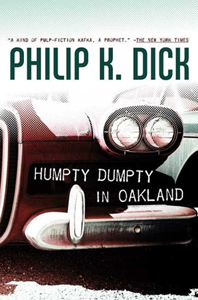“Humpty Dumpty in Oakland” (written in 1960, published in 1986) – the last-written of Philip K. Dick’s nine non-science fiction novels – is perhaps his most consistently darkly comedic novel. But it’s not a book that had me laughing as much as some others.
The author tones down the absurdism — instead favoring long stretches describing traffic and construction in the growing, crowded Bay Area – and we’re left with two people who are troubled in traditional and relatable (if slightly extreme) ways.
Blue-collar schmoes
“Humpty Dumpty” chronicles two blue-collar Joe Schmoes on San Pablo Avenue in Oakland. Jim Fergesson is a mechanic at one of the last of the successful one-man shops as the calendar turns to 1960. He fears he’ll die by a car falling off its hydraulic jack and crushing him.

“Humpty Dumpty in Oakland” (1986)
Composition year: 1960
Author: Philip K. Dick
Genre: Character drama
Setting: 1960, Oakland
By novel’s end, though, Al Miller is the POV character. It’s understandable why PKD doesn’t start with Al, a used-car salesman who often stands idly by and lets things happen to him. By comparison, the heart-attack-prone Fergesson – often dubbed “the old man,” even though he’s in his 50s – is dynamic.
As with “The Man Whose Teeth Are All Exactly Alike,” “Humpty Dumpty” shows how two rivals can misunderstand each other, leading to resentment grown from almost nothing. That novel is more of a farce, whereas this one gets into layers upon layers of paranoid thinking. “Humpty Dumpty” is ultimately a warning against paranoia, even though PKD writes about paranoia in the way of someone with an innate understanding.
In fact, Al Miller – who has a cinder-block shack in the middle of his used-car lot that calls to mind PKD’s writing shack – might be more of a stand-in for PKD than “the old man” is. Sadly and ironically, there’s a comparison to be made there, too.
Fergesson wants to strike it big in his career, hoping to use his lifetime earnings to buy in to a large, state-of-the-art auto shop in Marin County. But his heart troubles might not allow him to see that day. PKD, as fans know, was starting to see serious commercial success and critical appreciation right before his death in 1982.
An active mind
Miller believes record-producing magnate Chris Harman – who tips off Fergesson about the Marin County opportunity – is a crook who is going to fleece Fergesson. (As much as Al resents Jim for selling the garage, which means Al needs to find a new used-car lot, he also refers to Jim as his “best friend” at one point, and he looks out for his best interests.)
Al isn’t active in terms of taking action, but his mind is active, and he often jumps on the latest thing he has heard. These tidbits of information often come from his Negro friends, who speak in Ebonics. People like real-estate lady Mrs. Lane and jack-of-all-trades Tootie Doolittle are colorful and amusing, for sure, but closer to inner-city stereotypes than we might expect from PKD.

The one time in the novel that Al really goes for something, he fuels himself beforehand with multiple counteracting drugs and a couple of Anacin (a period touch that “Family Guy’s” Stewie would appreciate). Temporarily driven by the drugs, he talks himself into a job at Harman’s company.
In an even wilder climactic sequence, several main characters converge for a bizarre showdown at Harman’s lavish house. Fergesson is fighting through chest pains but trying to act like a cool wheeler and dealer, and Al also happens to be there, on his first day of working for Harman as a barbershop record producer.
The way everything comes together in crazy fashion – yet in a manner carefully constructed by the author – reminds me of the ending of Quentin Tarantino’s “Once Upon a Time … in Hollywood.” If “Humpty Dumpty” is ever made into a film, this will be a showcase scene for the actors.
Saddest of sad sacks?
Al is in some ways the saddest of all PKD sad sacks, with one of his friends calling him a “Humpty Dumpty” — he always falls back to the bottom. But Al’s observations about class differences, and the way his low-class status affects his job prospects and encounters with the law, are not wrong.
He recognizes that he doesn’t catch breaks like other people (Fergesson, Harman) do, and he doesn’t know how to position himself for those breaks. We’ve all felt at times like we don’t know the secret handshake.
That said, PKD isn’t ranting about the struggles of the lower class or demonizing the upper class via this used-car seller. PKD describes Al’s worst offenses as a shady dealer. Also, it’s hardly a twist that Harman turns out to be a genuinely good guy all along, with all of Al’s assumptions about the man being dead wrong.
In the final pages, in fact, Al actually has something randomly good happen to him. All along, there might’ve been an undercurrent of hope playing behind this pessimistic novel. It’s just hard to find it because Al is always thinking down the other path.

